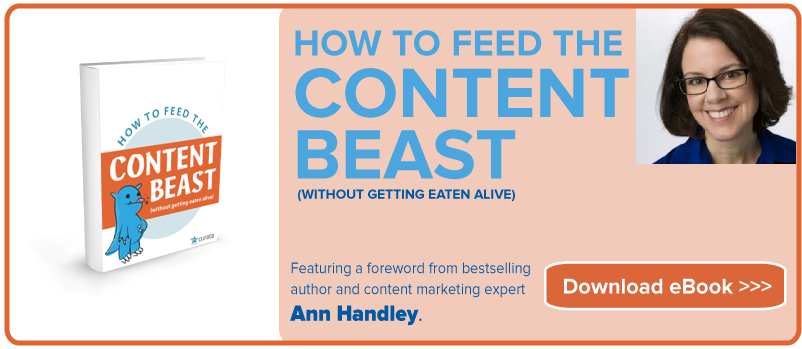- Share SEO Survival Guide: 10 Tips for Content Marketing Success on Facebook
- Share SEO Survival Guide: 10 Tips for Content Marketing Success on Twitter
- Share SEO Survival Guide: 10 Tips for Content Marketing Success on Linkedin
- Share SEO Survival Guide: 10 Tips for Content Marketing Success via email
Just a few years ago, articles about SEO consisted almost entirely of advice on how to carry out the day-to-day technical aspects of keyword research, on-site optimization and link building. While these elements are certainly still necessary, their importance has declined and changed quite significantly.
Instead, marketers must create quality, long form content, and use SEO as just one of many content amplification strategies.
This article will walk you through the elements of SEO that are still important for content marketing success today.
1. Focus more on user intent and semantic search and less on individual keywords.
Since the release of Hummingbird last year, we’ve seen a shift away from keyword targeting in favor of focusing on semantic search. Google has become far more sophisticated when it comes to understanding the meaning behind search queries; so rather than returning a page based simply on keyword density, for instance, they’re able to return content that matches the actual meaning and intent behind the request.
When creating content, focus on questions your target market may be asking, rather than simply on two to three word catchphrases. Write meaty articles that cover all aspects of a particular topic, rather than writing shorter posts that target a popular keyword or phrase. Focus on the intent behind what your customers are looking for, and on how and where they’re using search (for instance, on mobile).
2. Create a mobile content marketing strategy—it’s essential in today’s world.
According to the Mobile Path to Purchase report, 60% of consumers use mobile exclusively to make purchase decisions. This should both excite and terrify marketers.
Optimizing for mobile is no longer simply about making sure you have a responsive website or a mobile app. Every aspect of your website and content needs to be optimized for mobile. In fact, I would argue that ‘mobile friendly’ should be replaced by ‘mobile first’. Here are 10 steps to creating a mobile-first content marketing strategy.
3. Work less on technical strategies and more on relationship building.
Many marketers have already figured out that simply having a technically sound SEO strategy in place isn’t enough. High search rankings can no longer be achieved simply by creating keyword-rich content, or by focusing on technical SEO compliance.
Rather, we’re seeing a shift towards relationship-based strategies like blogger outreach campaigns, reaching out to influencers on social media, and building relationships with brand advocates.
First, make sure your site and content are technically sound, and then move on to building and nurturing relationships that can be mutually beneficial for a long time to come.
4. Focus on hard-earned, high-quality links.
Link building is no longer about submitting your site to directories or asking other webmasters to include a link to your site. Instead, marketers should be focusing on building relationships and earning high-quality links through methods such as:
- Guest blogging on high-quality sites (See this guide for more benefits of guest blogging).
- Creating amazing resources that will naturally attract social shares and inbound links.
- Syndicating your content on popular sites in your niche (e.g. Business2Community).
- Reaching out to influential bloggers to form mutually-beneficial relationships.
For more ideas, see this refresher on link building for content marketing.
5. Remember to keep SEO in its proper place.
Too often I see business owners overblowing the importance of SEO. Don’t get me wrong: SEO is important, but it should only be one part of your overall digital marketing strategy.
Be sure to balance your focus and resources between the various sources of website traffic you’ll receive: social media, referral traffic from other sites, direct traffic, and offline referrals. Ideally, you’ll want these sources of traffic to be fairly evenly balanced. Putting all your efforts into SEO traffic can be dangerous: one algorithm change, and 90% of your traffic can potentially disappear overnight.
6. Optimize your on-page content.
Choosing a variety of long-tail key phrases that focus on conversational queries (for instance, “How do I cook a turkey?”) is still important, despite what my previous points may have suggested.
To optimize your on-page content, incorporate your key phrases into your:
- URLs: For example, blog.com/how-to-cook-a-turkey
- Title tag
- Heading tags (H1, H2, etc.)
- Throughout your content
- Alt image tags and image captions, where appropriate
Focus on creating content that can act as a definitive source on a topic, rather than simply targeting one or two keywords. One example of this is Curata’s Comprehensive Guide to Content Marketing Analytics & Metrics.
Long-form content stands a far better chance of ranking highly in the search engines; however this needs to be balanced with the fact that shorter, ‘catchier’ content may perform better for your mobile visitors.
7. Don’t forget about content distribution.
While this isn’t necessarily an SEO tip, it’s too important to leave out. In our rush to create more and more content in order to feed the content beast, many of us are neglecting to sufficiently promote and distribute content.
Optimizing for search is important, however according to one study, it typically only drives around a third of all website traffic. How else are you driving traffic to your valuable content?
In my post Why No One’s Reading Your Marketing Content, I outline some effective strategies for distributing your content:
- Design a modular yet cohesive content plan: Create small bits of content that can be used in a variety of ways to maximize your resources. Use these ‘modules’ to lead your followers and readers through the purchase process.
- Segment your audience: Customize your content to various segments of your audience to increase relevancy and conversions.
- Pay for distribution: Social ads are huge in 2015, as are native ads on popular sites (like ‘suggested posts’ below a site’s own content).
- Reach out to influencers: Focus on building relationships with influencers in your niche; once you’ve established these important connections, inbound links and social sharing of your content is often a natural result.
See Curata’s list of content promotion tools for a complete list of technologies that can help aid the distribution process.
8. Use an integrated approach to SEO rather than a segmented approach.
As already mentioned, SEO is no longer an isolated task that can be performed in a vacuum. Content marketing, SEO and social media all work hand in hand to drive traffic, build relationships and trust and grow your audience.
A large part of this will be understanding how to move your various leads through your funnel: for instance, attracting large volumes of traffic via search and social media, and then appropriately filtering this traffic through directing readers to various types of targeted content through your website and email content.
Ultimately, each stream of traffic should end up at a targeted, enticing offer, such as an eBook or webinar.
9. Ensure social media is a key component alongside your SEO strategy.
Articles with a large amount of social shares have been shown to increase search rankings (if not directly, than certainly indirectly through increased reach and visibility).
Being present and active on social media could act as a ‘brand signal’ to search engines that your content is credible and trustworthy. In this way, having a strong social media presence is no longer a ‘nice to have’ but a ‘must have’.
See this post, 11 Effective Ways to Use Social Media to Promote Content, for more tips on promotion.
10. Most importantly: Concentrate on writing content your audience will find true value in.
Amazing content will become evergreen and will drive traffic for months or years to come. Don’t be afraid to over-invest in high-quality content that adds something interesting, unique, or insightful to the conversation. Sometimes it can take up to a year or two for a piece of content to truly hit its stride; so don’t be disheartened if your amazing article or blog post takes a while to catch on.
As your content gets shared on social media, it will accumulate more views. And as more people read it, it will naturally earn more inbound links, thus increasing your organic search rankings. If your content is non-egocentric, adds value, and you’re exposing it through all your channels, eventually it will get the attention it deserves.
What would you add to this list? What are your best SEO tips for content marketing success?
For more tips on creating quality content, see Curata’s free eBook, How to Feed the Content Beast (Without Getting Eaten Alive).














